The artifacts stolen from Turkey, which harbors the remains of countless civilizations, are now displayed in museums around the world.
Turkey has held a significant place in the history of humanity throughout different eras. As a result, it is possible to come across traces of numerous civilizations in this land. However, for Turkey, often referred to as an open-air museum, illegal excavations and damage pose a significant problem. In the past, many artifacts from Turkey were either stolen or legally taken to other countries. Even today, there is a possibility that many artifacts discovered in illegal excavations may be seen in museums in other countries in the years to come.
Let’s together learn about which countries some of these artifacts are located in. We hope that all artifacts and structures will return to their original geographical locations.
Nereid Monument (British Museum)- The artifacts stolen from Turkey

The magnificent Nereid Monument was unearthed in the ancient city of Xanthos, which is now within the borders of modern-day Kas. It is the largest and the first temple-like tomb of its kind in Anatolia. It is believed to have been built around 390 BC in honor of Arbinas, a king of the Xanthos Dynasty who ruled western Lycia under the Achaemenid Empire. The monument, named after the Nereid (sea nymph) statues placed between its columns, clearly reflects the influence of both Persian and Greek cultures on the Lycian civilization. Discovered by Charles Fellows in 1840, it was nearly completely dismantled and transported to London by ship. Today, its reconstruction is among the most important exhibits at the British Museum.
Here is the place where it belongs
Pergamon Altar (Pergamon Museum) – the artifacts stolen from Turkey
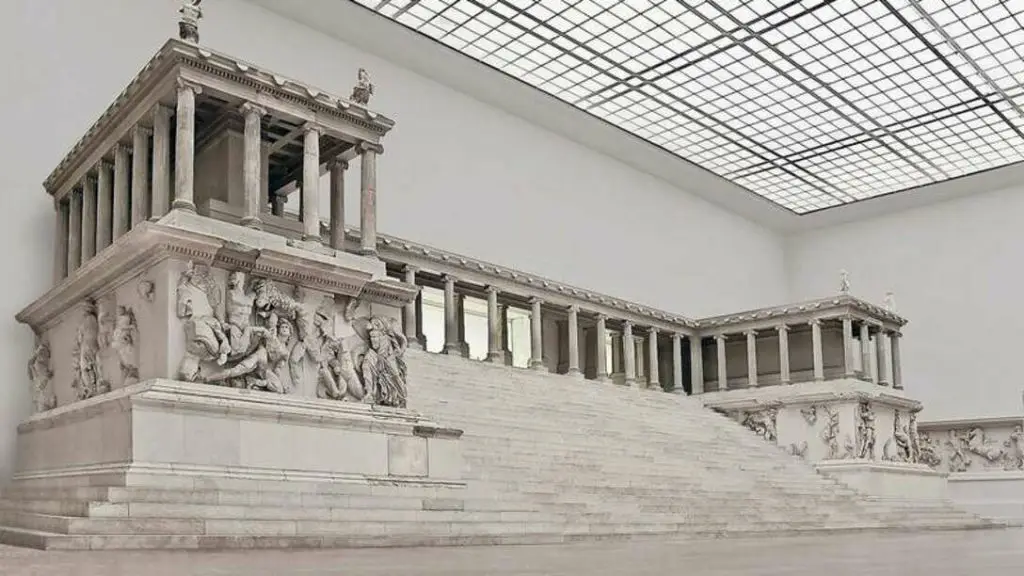
With its impressive size, the Pergamon Altar resembles a temple, so much so that the Athena Temple could fit inside its inner courtyard. This 10-meter-high marble structure is 35 meters wide and 33 meters deep. It is believed that construction began after Pergamon’s King Eumenes II decisively defeated the Galatians in Magnesia around 180 BC. The altar stands out for its reliefs, depicting the battle between the Gods and the Giants, which are among the most important plastic works of the Hellenistic period. It is supposed to be in the ancient city of Pergamon in Turkey. The courtyard of the altar features the Telephos Frieze, which tells the heroic mythological origins of the Attalid dynasty. The remains of this magnificent structure were transported to Germany by Carl Humann in the 1870s. Today, it is displayed at the Pergamon Museum in Berlin.
Here is the place where it belongs
Mosaic from Halicarnassus (British Museum) – the artifacts stolen from Turkey
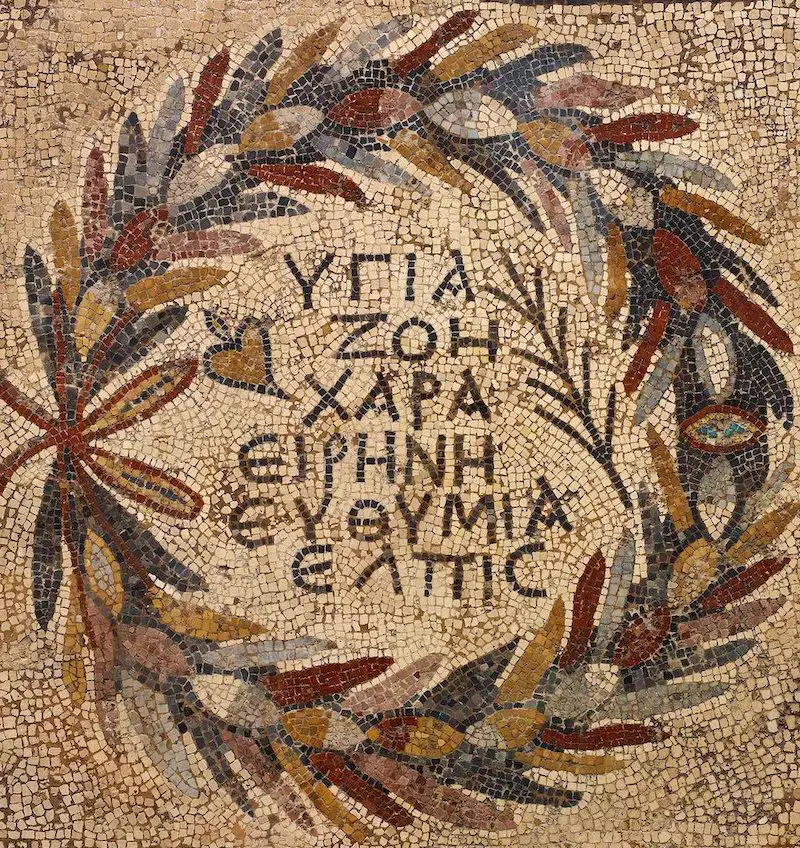
This stone mosaic, dating back to the Late Roman period, features Greek words for Health, Life, Joy, Peace, Happiness, and Hope, written in a black frame around a laurel wreath. Measuring 1.14 meters by 1.14 meters, the artwork is dated to the 4th century AD. Found in the ancient city of Halicarnassus, located in present-day Bodrum, Turkey, it is now part of the British Museum’s collection.
Here is the place where the artifacts stolen from Turkey belong
Great Diadem from Troy (Pushkin Museum) – the artifacts stolen from Turkey
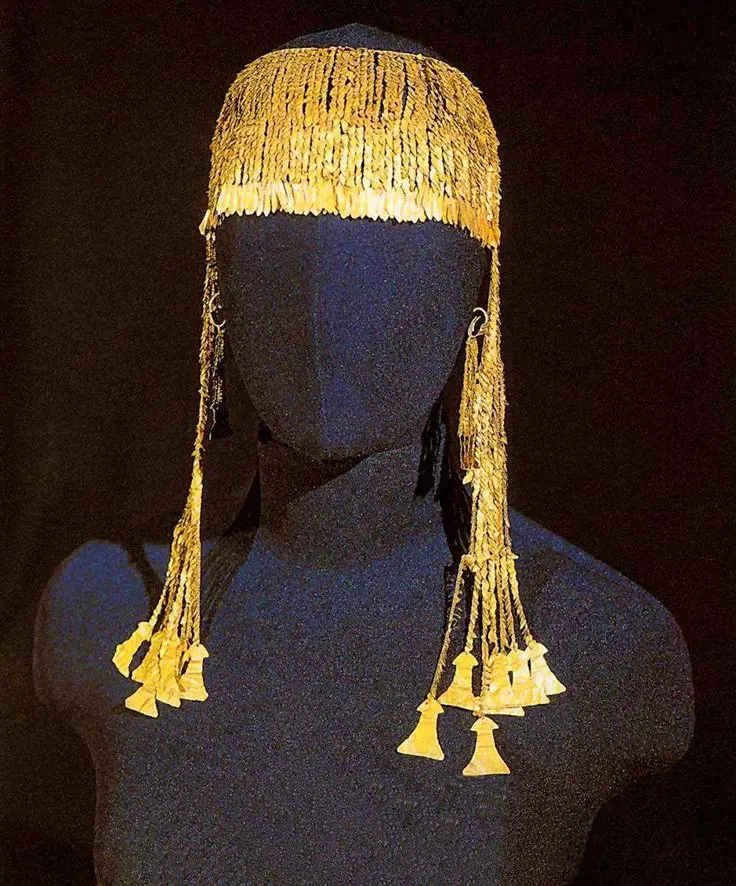
The Great Diadem, an exceptional example of ancient jewelry art, was found in the second layer of Troy and is estimated to date back to approximately 2400-2200 BC. It was discovered by Heinrich Schliemann and subsequently taken to Athens. Today, it is housed in the Pushkin Museum in Moscow. In the third photo, you can see Heinrich Schliemann’s wife, Sophia Schliemann, with the Troy artifacts. the Ancient city of Troy takes places in Dardanelles in Turkey.
Here is the place where diadem belongs
Knidos Lion (British Museum) – the artifacts stolen from Turkey
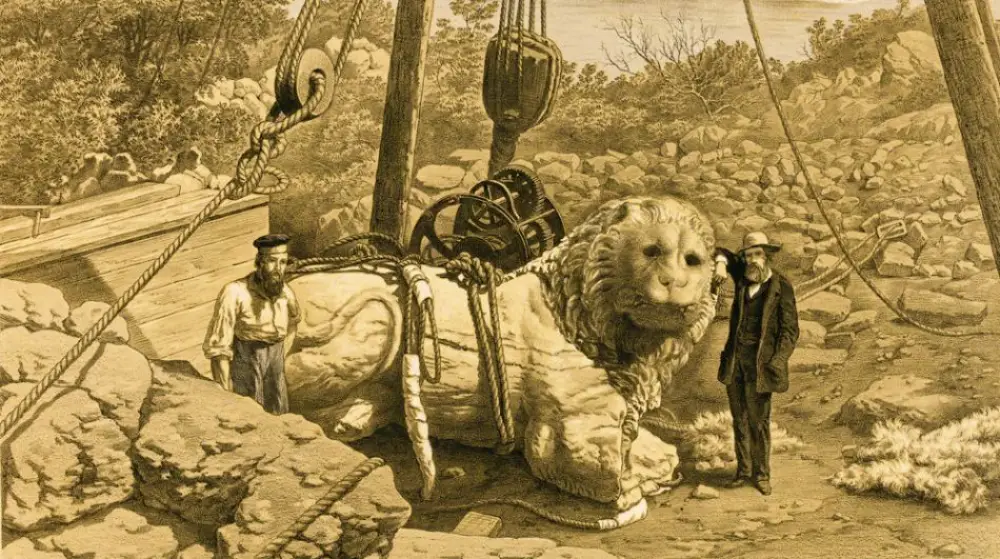

This colossal marble lion was found in a burial area near the ancient city of Knidos, located on the southwestern coast of Turkey, near modern-day Datça. The marble was brought from Pentelicus Mountain near Athens. The lion is missing its lower jaw and front paws, and its eyes were once likely filled with metal or glass. While its exact dating is uncertain, it is believed to have been created in the 2nd century BC. Discovered by British archaeologist Richard Popplewell Pullan in 1858 during excavations of the Knidos ancient city, most of the lion’s sculptures and friezes are now displayed in the British Museum’s Lycian Hall.
Here is the place where Knidos Lion belogs
South Agora Gate of Miletus (Pergamon Museum) – the artifacts stolen from Turkey
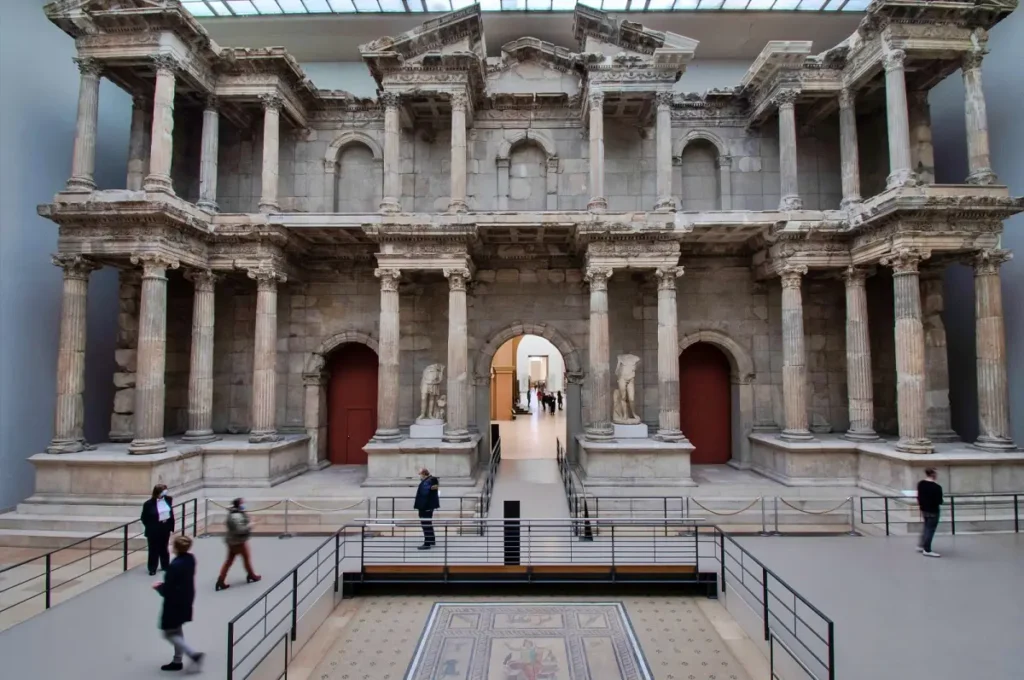
This two-story gate, nearly 29 meters wide and 17 meters high, is believed to have more than 60% of its original marble pieces. It was constructed in the early 2nd century AD in the bustling trading city of Miletus, serving as a grand passageway between the Agora and South Market. Like many marble structures and statues of the classical ancient period, it was originally colorful and housed sculptures. In 1899, German archaeologists began excavations in the ancient city, and the gate was transported to Germany. It now resides in the Pergamon Museum in Berlin, weighing a total of 750 tons.
Here is the place where South Agora Gate of Miletus belongs
Bronze Aphrodite Bust from Satala (British Museum) – the artifacts stolen from Turkey
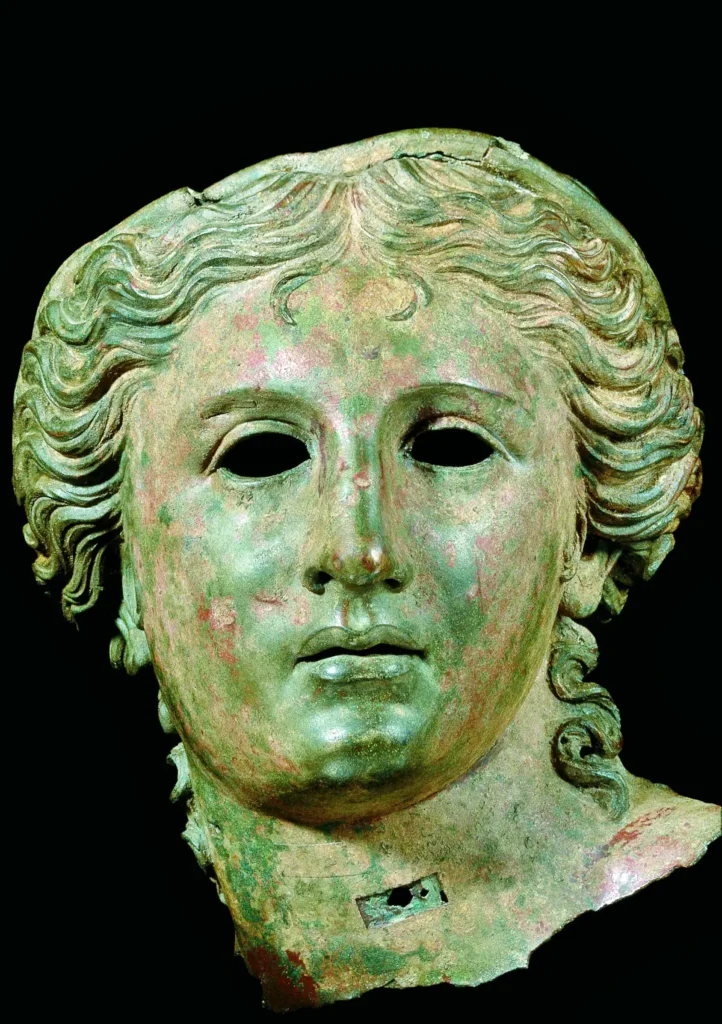
In 1872, during excavations in the ancient city of Satala in Gumushane, a bronze object was found. This bronze bust of Aphrodite later traveled to Istanbul and Italy. In Italy, it was eventually sold to the British Museum. While there are rumors that the entire bronze sculpture was discovered, its body has never been found. The bust has traces of a hoe on its lower part but its face is remarkably well-preserved. It is believed that its eyes were filled with precious stones or glass paste. The artwork is dated to the 1st century BC.
Here is the place where ronze bust of Aphrodite belongs
Old Fisherman Statue (Pergamon Museum) – the artifacts stolen from Turkey

The head of a marble statue was discovered in the Tiberius Portico’s pool in the ancient city of Aphrodisias in Aydın. Professor Dr. Kenan Erim identified this head as belonging to the Roman-era statue known as the “Old Fisherman,” displayed in the Old Museum in Berlin. The statue’s body, discovered in the ancient city in 1904, was subsequently smuggled abroad by French archaeologist Paul Gaudin.
As a result, efforts have been made for years to return the head and arm portions to Turkey, which are on display at the Aphrodisias Museum in Geyre.
Three Graces Mosaic from Antioch (Louvre Museum) – the artifacts stolen from Turkey

According to an inscription found in Perge, the name “Titus Phlavius Clemens Pelopidianos” is mentioned among the city’s noble families. Researchers later discovered the same name on the base of the Tyche statue displayed in Belgium’s Royal Museum of Art. This confirmed that the statue originated from the ancient city of Perge. While efforts have been initiated to repatriate the artwork, there hasn’t been a resolution yet.
Tyche, known as “Fortuna” in ancient Rome, was the goddess of rivers and streams, a daughter of the Oceanus. In ancient Greece, she was considered the goddess of fate, fortune, and success. Tyche is typically depicted in her statues holding a cornucopia or a ship’s rudder, symbolizing control over people’s destinies. Thee Graces Mosaic is supposed to be in the Ancient city of Perge in Antalya.
Here is the place where Three Graces Mosaic from Antioch belongs
Seasons Mosaic from Antioch (Louvre Museum)

This mosaic depicting the seasons and hunting scenes dates back to around AD 325. It was discovered in the Harbiye (Daphne) region of Antioch and is now displayed in the Louvre Museum.
Here is the place where seasons mosaic belongs
Mausoleum of Halicarnassus Ruins (British Museum) – the artifacts stolen from Turkey

This monumental tomb was built for King Mausolus of Caria and is also considered one of the Seven Wonders of the Ancient World. It featured a unique architectural synthesis of Greek and Egyptian styles. It stood about 40 meters tall and was extravagantly decorated with numerous sculptures, including statues of Mausolus and his wife Artemisia. Due to an earthquake in the 15th century, only a few remnants of it remain in Bodrum, where it is displayed as an open-air museum. The sculptures that once adorned the Mausoleum, including those of Mausolus and Artemisia, marble relief panels, and the chariot that crowned the pyramid roof, were taken to England by archaeologist Charles Thomas Newton in 1857 and are now part of the British Museum’s collection.
This is the place where these artifacts belong
Athena Temple Propylon from Pergamon (Pergamon Museum) – the artifacts stolen from Turkey

The Athena Temple, dedicated to the goddess of strategy, art, and warfare, Athena, was one of the most important structures on the Pergamon Acropolis. It was the first and only Doric temple of Archaic Anatolian architecture, built in the second half of the 6th century BC. While many parts of the Athena Temple were transported to the Pergamon Museum in Berlin for faithful reconstruction, only the foundations remain in the Ancient city of Pergamon.
The Athena temple belongs to Pergamon Acropolis in Turkey
Payava Lycian Sarcophagus from Xanthos (British Museum)

The Payava Lycian Sarcophagus, dating back to the 4th century BC, was taken to the British Museum from the ancient city of Xanthos in 1884. This two-chambered and relief-adorned sarcophagus is one of the magnificent works of the city. The name Payava is known only from this sarcophagus inscription. While the bottom layer of the monument is in Turkey, the other three layers are currently displayed at the British Museum.
Tyche Statue from Smyrna (National Archaeology Museum, Belgium)

In a inscription found in Perge, the name of “Titus Phlavius Clemens Pelopidianos,” one of the noble families of the city, was mentioned. Researchers later discovered that this name also appeared on the pedestal of the Tykhe statue displayed in Belgium as “T(itus) Fl(avius) Clemens Pelopidianus,” confirming that the statue originated from the ancient city of Perge.
Efforts to communicate with the Royal Art Museum of Belgium, where the artifact is currently exhibited, have been initiated for its repatriation, but no conclusion has been reached yet.
Tykhe, known as “Fortuna” by the Romans in the ancient world, was the daughter of Okeanos, the god of seas and rivers. In ancient Greek culture, Tykhe was regarded as the goddess of fate, fortune, and success. In sculptures, she is often depicted holding a cornucopia, symbolizing abundance, and sometimes believed to be holding a ship’s rudder, signifying her control over human destinies.
İzmir in Turkey is the city where this Tyche Statue belong
Harpy Tomb from Xanthos (British Museum) – the artifacts stolen from Turkey

The Lycian region is famous for its rock-cut tombs from ancient times. The Harpy Monument, dating back to around 480-470 BCE, is one of the earliest and most important Lycian monuments, serving as a tomb chamber. This 8.87-meter-long monument, constructed near the Xanthos theater, features scenes depicting mythological figures, the presentation of gifts to a king, and a funeral procession.
Although the monument takes its name from the four-winged female figures resembling Harpies, there is a consensus today that these figures are not actually Harpies. The majority of the reliefs and friezes from the Harpy Monument, which is one of the most significant artifacts from the Xanthos Ancient City, are currently displayed in the Lycian Gallery of the British Museum.
The Lycian area starts from Fethiye and finishes in Antalya. This area is the place where Harpy Tomb from Xanthos belongs
Tyche Head from Antalya’s Korydalla (Dumbarton Oaks Museum / USA)

The “Sion Eserleri” (Sion Artifacts) comprise a group of liturgical church items made of gold and silver, dating back to the 6th century AD and discovered in the ancient city of Korydalla in Antalya’s Kumluca district. Some of the items are under protection at the Antalya Museum, while others were illegally smuggled out of Turkey and sold to the Dumbarton Oaks Museum in the USA. Negotiations are ongoing for the repatriation of these artifacts to Turkey.
Turkey has always been exposed to these problems. Recently, A woman from Belgium has been accused of stealing a historical artifact and she may be taken into custody in Turkey.
1 comment
Saved as a favorite, I love your blog!